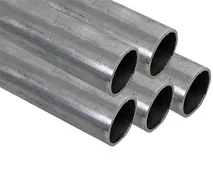Understanding the Properties and Applications of Cold Rolled Pipes in Industry
Nov . 24, 2024 05:05
Understanding Cold Rolled Pipes Features, Manufacturing Process, and Applications
Cold rolled pipes are a crucial component in various industries due to their superior mechanical properties and precise dimensions. These pipes are produced through a process that involves rolling the metal at room temperature, which imparts several advantages over other manufacturing techniques such as hot rolling. This article will delve into the features, manufacturing process, and applications of cold rolled pipes, providing a comprehensive understanding of their importance in modern engineering.
Features of Cold Rolled Pipes
Cold rolled pipes exhibit a range of desirable characteristics that make them suitable for diverse applications. One of the most significant features is their enhanced strength. The cold rolling process increases the steel's yield strength and tensile strength, making it ideal for structural applications where heightened durability is required. Furthermore, the cold working technique improves the surface finish of the pipes, resulting in a smoother surface that is less prone to corrosion and wear.
Additionally, cold rolled pipes have tighter tolerances compared to hot rolled pipes. This characteristic allows for more accurate machining and assembly in various applications. Their uniform dimensions mean that they can be easily integrated into existing systems without the need for extensive modifications.
Cold rolled pipes also demonstrate excellent dimensional stability and minimal cross-sectional distortion. These properties are particularly beneficial in applications where precision is paramount, such as in the aerospace and automotive industries.
Manufacturing Process
The manufacturing of cold rolled pipes begins with the selection of high-quality raw materials, typically carbon steel or alloy steel. The initial step involves heating the raw steel to a temperature above its recrystallization point, followed by hot rolling to form a pipe shape. While hot rolling helps to create the basic dimensions, it does not provide the final mechanical properties that cold rolling achieves.
Once the hot rolled pipes are formed, they undergo the cold rolling process. This involves passing the pipes through a series of rollers at room temperature. The cold working compresses the material and alters its microstructure, contributing to the increased strength and improved surface finish.
cold rolled pipe
After the cold rolling process, the pipes may undergo additional treatments such as annealing, which helps to relieve internal stresses and improve ductility. The pipes are also subjected to surface treatments such as pickling to remove oxides and scale, ensuring a clean finish that enhances corrosion resistance.
Applications of Cold Rolled Pipes
Due to their enhanced properties, cold rolled pipes are employed in a wide variety of applications across multiple industries. In the construction sector, these pipes are often used for structural support and framework due to their strength and durability. They are also commonly found in the manufacture of scaffolding, handrails, and supports.
In the automotive industry, cold rolled pipes play a critical role in the production of chassis components and exhaust systems. Their ability to withstand high pressures and maintain structural integrity under stress makes them an ideal choice for applications that demand reliability.
Moreover, the oil and gas industry utilizes cold rolled pipes for transporting fluids and gases due to their robust characteristics. Their resistance to corrosion and mechanical stresses is essential for ensuring the safety and efficiency of pipelines.
Finally, cold rolled pipes are also prevalent in the furniture and appliance manufacturing sectors, where aesthetic appeal and structural integrity are vital.
Conclusion
Cold rolled pipes offer a combination of strength, precision, and durability, making them an indispensable material in many industrial applications. The cold rolling process not only enhances the mechanical properties of the steel but also provides a superior surface finish, allowing for greater versatility in design and use. As industries continue to evolve, the demand for high-quality cold rolled pipes is expected to grow, highlighting the ongoing importance of this manufacturing technique in modern engineering.
 Afrikaans
Afrikaans  Albanian
Albanian  Amharic
Amharic  Arabic
Arabic  Armenian
Armenian  Azerbaijani
Azerbaijani  Basque
Basque  Belarusian
Belarusian  Bengali
Bengali  Bosnian
Bosnian  Bulgarian
Bulgarian  Catalan
Catalan  Cebuano
Cebuano  Corsican
Corsican  Croatian
Croatian  Czech
Czech  Danish
Danish  Dutch
Dutch  English
English  Esperanto
Esperanto  Estonian
Estonian  Finnish
Finnish  French
French  Frisian
Frisian  Galician
Galician  Georgian
Georgian  German
German  Greek
Greek  Gujarati
Gujarati  Haitian Creole
Haitian Creole  hausa
hausa  hawaiian
hawaiian  Hebrew
Hebrew  Hindi
Hindi  Miao
Miao  Hungarian
Hungarian  Icelandic
Icelandic  igbo
igbo  Indonesian
Indonesian  irish
irish  Italian
Italian  Japanese
Japanese  Javanese
Javanese  Kannada
Kannada  kazakh
kazakh  Khmer
Khmer  Rwandese
Rwandese  Korean
Korean  Kurdish
Kurdish  Kyrgyz
Kyrgyz  Lao
Lao  Latin
Latin  Latvian
Latvian  Lithuanian
Lithuanian  Luxembourgish
Luxembourgish  Macedonian
Macedonian  Malgashi
Malgashi  Malay
Malay  Malayalam
Malayalam  Maltese
Maltese  Maori
Maori  Marathi
Marathi  Mongolian
Mongolian  Myanmar
Myanmar  Nepali
Nepali  Norwegian
Norwegian  Norwegian
Norwegian  Occitan
Occitan  Pashto
Pashto  Persian
Persian  Polish
Polish  Portuguese
Portuguese  Punjabi
Punjabi  Romanian
Romanian  Samoan
Samoan  Scottish Gaelic
Scottish Gaelic  Serbian
Serbian  Sesotho
Sesotho  Shona
Shona  Sindhi
Sindhi  Sinhala
Sinhala  Slovak
Slovak  Slovenian
Slovenian  Somali
Somali  Spanish
Spanish  Sundanese
Sundanese  Swahili
Swahili  Swedish
Swedish  Tagalog
Tagalog  Tajik
Tajik  Tamil
Tamil  Tatar
Tatar  Telugu
Telugu  Thai
Thai  Turkish
Turkish  Turkmen
Turkmen  Ukrainian
Ukrainian  Urdu
Urdu  Uighur
Uighur  Uzbek
Uzbek  Vietnamese
Vietnamese  Welsh
Welsh  Bantu
Bantu  Yiddish
Yiddish  Yoruba
Yoruba  Zulu
Zulu 












